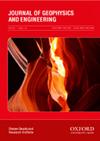Denoising for airborne transient electromagnetic data using noise-whitening-based weighted nuclear norm minimization
IF 1.7
3区 地球科学
Q3 GEOCHEMISTRY & GEOPHYSICS
引用次数: 1
Abstract
Recovering anomalous information covered under noise in late gates can enhance airborne transient electromagnetic (ATEM) detection. Conventional denoising mainly comprises filtering and gate correlation-based decomposition algorithms; the former fails to extract anomalies contaminated by noise and the latter relies on the correlation between gates, which may yield false late gate anomalies caused by early large-amplitude anomalies in early gates. In ATEM profiles, the correlation between anomalies in adjacent gates makes the anomalies to be measured to have low-rank characteristics relative to the noise-contaminated profiles; the noise is uniformly distributed in the profiles, which have nonlocal self-similarity. Therefore, the low-rank matrix approximation algorithm is applicable to ATEM data denoising. In this study, an algorithm—noise-whitening-based weighted nuclear norm minimization (NW-WNNM)—is designed to remove ATEM profile noise. First, we analyse the influence of patch size in block matching on anomalous and noisy patches and estimate the profile patch size adaptively. Then, we combine the estimation of noise variance in weighted nuclear norm minimization (WNNM) with the noise whitening of similar patch matrices to reduce the noise interference on the nuclear norm and add a whitening factor in the weight vector to make the soft-thresholding function applicable to the low-rank reconstruction of the whitened matrix. By analysing the reconstructed low-rank matrix and its feature distribution, compared with WNNM, NW-WNNM can detect the feature information more accurately and eliminate the influence of noise on the nuclear norm. Simulation and field profile results indicate that NW-WNNM is superior to comparison denoising methods.基于噪声白化的加权核范数最小化对机载瞬态电磁数据的去噪
在后栅中恢复被噪声覆盖的异常信息可以增强机载瞬态电磁(ATEM)检测。传统的去噪主要包括滤波和基于门相关的分解算法;前者不能提取被噪声污染的异常,后者依赖于门之间的相关性,这可能会产生由早期门中的早期大幅度异常引起的伪后期门异常。在ATEM剖面中,相邻闸门中异常之间的相关性使得要测量的异常相对于噪声污染剖面具有低阶特性;噪声均匀分布在具有非局部自相似性的轮廓中。因此,低秩矩阵近似算法适用于ATEM数据去噪。在本研究中,设计了一种基于噪声白化的加权核范数最小化(NW-WNNM)算法来去除ATEM轮廓噪声。首先,我们分析了块匹配中补丁大小对异常和噪声补丁的影响,并自适应地估计了轮廓补丁大小。然后,我们将加权核范数最小化(WNNM)中的噪声方差估计与相似补丁矩阵的噪声白化相结合,以减少噪声对核范数的干扰,并在权重向量中添加白化因子,使软阈值函数适用于白化矩阵的低阶重建。通过分析重构的低秩矩阵及其特征分布,与WNNM相比,NW-WNNM可以更准确地检测特征信息,并消除噪声对核范数的影响。仿真和场剖面结果表明,NW-WNNM方法优于比较去噪方法。
本文章由计算机程序翻译,如有差异,请以英文原文为准。
求助全文
约1分钟内获得全文
求助全文
来源期刊

Journal of Geophysics and Engineering
工程技术-地球化学与地球物理
CiteScore
2.50
自引率
21.40%
发文量
87
审稿时长
4 months
期刊介绍:
Journal of Geophysics and Engineering aims to promote research and developments in geophysics and related areas of engineering. It has a predominantly applied science and engineering focus, but solicits and accepts high-quality contributions in all earth-physics disciplines, including geodynamics, natural and controlled-source seismology, oil, gas and mineral exploration, petrophysics and reservoir geophysics. The journal covers those aspects of engineering that are closely related to geophysics, or on the targets and problems that geophysics addresses. Typically, this is engineering focused on the subsurface, particularly petroleum engineering, rock mechanics, geophysical software engineering, drilling technology, remote sensing, instrumentation and sensor design.
 求助内容:
求助内容: 应助结果提醒方式:
应助结果提醒方式:


